|
"The
secret art is not lost. Jimmy Wong brings back the Taiji
Legacy to America"
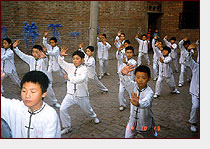 Wu
style or Hao style, better known as Wu (Hao) style today,
is created by Mr. Wu Yu-Xiang (1812-1880). It is one
of the 5 major Taijiquan systems in China today. The
Wu (Hao) family rose in the year of the Qing Dynasty
when Xiang Feng was the emperor. Mr. Wu Yu-Xiang who
was the founder of the taiji boxing born in Guangfu
town, Yongnian county, Hebei. He was a scholar. His
taiji skills were taught by Chen Qingping, (1795-1868)
who lived in Zhaopao, Wen County, Henan province. With
his Confucianism, Taoism, and Sun Tze Art of War background,
combined with his taiji skill and Mr. Wang Zhong-yue
taiji theory, he developed a powerful taijiquan for
health and martial arts. He also developed the 13 Taiji
Spear (staff), 13 Taiji Saber, and moving step push
hand applications. He carried on the research of Mr.
Wang Zhong-Yue theory and developed the "13-Torso
Method", "Analysis of Taijiquan theory",
"Introduction of the 13 Postures", and "Secret
of the Four Words". Mr. Wu Yu-Xiang had formed
a complete Taijiquan system. Mr. Wu taught his art to
his nephew, Mr. Li Yi-Yu (1832-1892) who also later
developed "The Secret of Five Words", "Taiji
Secret Attacks", and many other concepts. Because
Mr. Wu Yu-Xiang and Mr. Li Yi-Yu were high scholar Confucians,
they amazed themselves by studying the theories and
martial arts aspects of the Taijiquan. They were not
interested in teaching students. Mr. Li accepted Mr.
Hao Wei-Zhang (1849-1920) who later made it very popular
to the public. A famous Xingyi and Baqua teacher, Mr.
Sun-Lu Tang studied from him and created the Sun Style
Taijiquan. A very famous Chinese-Muslim scholar and
a businessman by the name of Mr. Li Shen-Duan in Xintai
studied from Mr. Hao Wei-Zheng. Mr. Li Shen-Duan taught
to many students in the Xintai area. The most famous
ones are Mr. Chen Gu-An, and Mr. Wu Wen-Han. Both taught
and accepted Mr. Jimmy Kokkhang Wong as their disciple. Wu
style or Hao style, better known as Wu (Hao) style today,
is created by Mr. Wu Yu-Xiang (1812-1880). It is one
of the 5 major Taijiquan systems in China today. The
Wu (Hao) family rose in the year of the Qing Dynasty
when Xiang Feng was the emperor. Mr. Wu Yu-Xiang who
was the founder of the taiji boxing born in Guangfu
town, Yongnian county, Hebei. He was a scholar. His
taiji skills were taught by Chen Qingping, (1795-1868)
who lived in Zhaopao, Wen County, Henan province. With
his Confucianism, Taoism, and Sun Tze Art of War background,
combined with his taiji skill and Mr. Wang Zhong-yue
taiji theory, he developed a powerful taijiquan for
health and martial arts. He also developed the 13 Taiji
Spear (staff), 13 Taiji Saber, and moving step push
hand applications. He carried on the research of Mr.
Wang Zhong-Yue theory and developed the "13-Torso
Method", "Analysis of Taijiquan theory",
"Introduction of the 13 Postures", and "Secret
of the Four Words". Mr. Wu Yu-Xiang had formed
a complete Taijiquan system. Mr. Wu taught his art to
his nephew, Mr. Li Yi-Yu (1832-1892) who also later
developed "The Secret of Five Words", "Taiji
Secret Attacks", and many other concepts. Because
Mr. Wu Yu-Xiang and Mr. Li Yi-Yu were high scholar Confucians,
they amazed themselves by studying the theories and
martial arts aspects of the Taijiquan. They were not
interested in teaching students. Mr. Li accepted Mr.
Hao Wei-Zhang (1849-1920) who later made it very popular
to the public. A famous Xingyi and Baqua teacher, Mr.
Sun-Lu Tang studied from him and created the Sun Style
Taijiquan. A very famous Chinese-Muslim scholar and
a businessman by the name of Mr. Li Shen-Duan in Xintai
studied from Mr. Hao Wei-Zheng. Mr. Li Shen-Duan taught
to many students in the Xintai area. The most famous
ones are Mr. Chen Gu-An, and Mr. Wu Wen-Han. Both taught
and accepted Mr. Jimmy Kokkhang Wong as their disciple.
Wu
(Hao) Characteristics
The characteristics of Wu (Hao) Taijiquan can be summarized
as follows:
| 1) |
Simple postures, but complicated techniques. |
The
posture and actions are simple, compact, and
brisk, but have profound meanings and very
practical. For example, 'Lazyman Ties His
Coat' is an attack on his opponent's face
and body. The upper hand is used to uproot
and the lower hand is used to fa-ching (attack)
- see fig. 1 & 2. |
| 2) |
Strict
demands of upright body and relaxed posture. |
The
hip needs to be naturally tucked in, the back
straightened, the shoulders loosened, and
elbows sunken. The idea is to protect the
crotch, straighten the spine, control the
mind, and let the vital energy go into the
dantian (Qi reservoir). At this point, we
are ready to ambush, jump, remove, dodge,
and turn at anytime. As Mr. Wu Yu-Xiang said,
"As firm as a tree and as flexible as
a wheel." Two palms protect the front
and do not stretch them out beyond the foot
and toes. The elbows don't stick to the ribs.
Left connects with right, and up follows down.
The mind links with the body. |
| 3) |
To
control the Qi (vital energy) with the mind. |
To
use the mind to direct the Qi to the body
movement like Mr. Wu Yu-Xiang said "to
use the mind, not muscle", let the Qi
flow around the body |
| 4) |
To
be coherent |
All
movements have to be consistent, avoiding
all possible shortcomings of broken links
in the movement. You have to be aware of the
body movements and be ready at all times.
Mr. Wu Yu-Xiang said, "to gather the
strength is to draw a bow, to let out the
energy is to shoot the arrow". |
|
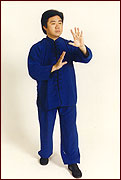
Fig. 1 - Jimmy Wong performs Wu (Hao) 'Lazyman
Ties His Coat' |
|
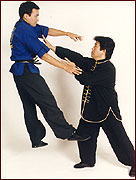
Fig. 2 - Application of Wu (Hao) Taiji 'Lazyman
Ties His Coat' |
Wu
(Hao) Complete System
The complete system of the Wu (Hao) style are:
| 1)
First routine |
a.
13 Posture
b. 24 Posture
c. 32 Posture
d. 36 Posture |
| 2)
2nd Routine: Long Form 108 Posture |
| 3)
Taiji jian (straight sword) |
| 4)
Taiji dao (sabre) |
| 5)
Taiji qiang (spear) |
| 6)
Taiji gun (pole) - developed by Mr. Chen Gu-An |
| 7)
31/2 Step Tui-Shou (Push Hand Drills/Applications) |
| 8)
32 Duan Da (quick fighting techniques) |
| 9)
Free Style Tui-Shou (Push Hands/Sparring) |
| 10)
Wang Zhong-yue, Wu Yu-Xiang, Li Yi-Yu Taiji Classical
Theory |
The
development of Wu (Hao) Taijiquan
Mr. Wu Yu-Xiang is the creator of the Wu, or better
known today as Wu (Hao), Taijiquan, and also the founder
of Taijiquan theory. Mr. Wu Yu-Xiang (1812-1880) was
born in Guangfu town, Yongnian County, Hebei province.
He came from a distinguished royal family of the government.
He has two elder brothers and his great-grandfather
Wu Jingyuan was a high-ranking officer in the Qing Dynasty
army. His grandfather, Wu Dayong, was a martial arts
warrior in Xintai (one who passed the imperial examination
at the county level in the Ming and Qing Dynasties).
Wu Yu-Xiang's father, Wu Lee was a scholar, his elder
brother Wu Chengqing, who passed the imperial examination,
was the county mayor of Wuyang county, Henan province.
His other brother, Wu Ruqing, also passed the imperial
exam and worked as the chief inspector in the security
department in Sichuan province. Mr. Wu Yu-Xiang himself
was a scholar, educator, and worked as the leader for
education.
Although
all of the Wu's members are Confucian Scholars and all
passed their examinations to be government officials,
kungfu was also a tradition in the Wu's family. They
believed in education and martial arts go together in
what the Chinese called 'Wen Wu Her I (Warrior Scholar).
The Wu brothers learned the kungfu from their father
since their childhood. At that time, there was a Chinese
medicine shop west of Yongnian county named Dahetang.
The owner of the shop was named Chen Dehu. He was from
Chen Jiagou Wen county, Henan province (the birthplace
of Taiji). Mr. Chen rented a room from the Wu's family.
Mr. Wu Yu-Xiang was very much into martial arts and
started learning from him. He found out that that his
kungfu was very different from Mr. Chen's, so he practiced
the Taiji with him but later he found out that his skill
was only mediocre. During that time, a man who lived
in Yongnian county named Mr. Yang Lu Chan (1799-1872),
the founder of Yang style taiji, came back home from
Chenjiagou. He had acknowledged all the taiji skills
from Mr. Chen Zhang Xing, came back and worked as a
martial arts coach for Dahetang Chinese Medicine Shop.
Mr. Wu and his brother knew that Mr. Yang had superb
martial skills so they made friends and learned taijiquan
from him.
Mr.
Wu Yu-Xiang found many questions when he studied taijiquan.
Later he heard a man in Zhaobao Wen County by the name
of Mr. Chen Qing-ping was an expert in taijiquan. In
1852, the elder brother of Mr. Wu Yu-Xiang was appointed
as the governor of Wuyang County in Henan province.
With his mother's permission, Mr. Wu Yu-Xiang set his
trip to visit his brother. However, he detoured to Zhaobao
town of Wen County to visit Mr. Chen Qing-ping. Immediately,
he studied from Mr. Chen diligently. Later, he also
found Mr. Wang Zhong-yue Taijiquan manual in the salt
factory of his brother's mansion. He was very excited
and enlightened by the book. Mr. Wu Yu-Xiang gave up
his official career and devoted all his life to the
study of taijiquan. He spent the next nine years with
his nephew, Li Yi-Yu to improve their taijiquan skill.
With his Confucian theory, Sun Tze Art of War, Qigong,
traditional Chinese medicine concepts, and martial arts
skills, he formulated the following theory:
1)
Explanation of 13 Postures
2) Taijiquan theory
3) Analysis of Taijiquan theory
4) 13 Torso Method
5) The Four secret words of Tuishou
Passing
Wu (Hao) Down
He created a new Taiji posture that has martial art
skill, health building through harmonizing the mind
and the body. He revised some moves of the posture to
make the names match reality. He improved and recreated
the Taiji Tuishou, 13 Spear (staff), 13 Sabre, 4 Spear
(staff), 4 Sabre and found a complete Wu (Hao) taijiquan
system for us today. Mr. Wu devoted all his life to
the study of taijiquan and has attained great achievement.
Limited by the family customs and royal status, he only
practiced taijiquan to amuse himself and was reluctant
to teach students. Other than his nephew, Li Yi-Yu and
Li Qingxuan, Yang Ban Hou also learned his expert martial
skills. Mr. Yang Ban Hou (1837-1892) was the second
son of Mr. Yang Lu-Chan. Mr. Yang followed Mr. Wu when
he was very young. He was often sleepy when he was reading,
so Mr. Wu taught him taijiquan. When he was 20 years
old, Mr. Yang Ban-Hou already an accomplished martial
artist, went to Peking (Beijing) to help his father
Mr. Yang Lu Chan teach taijiquan. With Mr. Wu and his
father coaching, Mr. Yang Ban-Hou's style was called
Small Posture Yang Style. The founder of the other Wu
(Woo) style, Mr. Wu Quan-You studied from Mr. Yang Ban-Hou.
Mr. Li Yi-Yu (2nd generation Wu (Hao) style) was the
elder nephew of Mr. Wu Yu-Xing. He is also a scholar.
Influenced by Mr. Wu, he gave up their official career.
Mr. Li paid tremendous amounts of time on his taijiquan
practice. Some masters said that Li Yi-Yu may have surpassed
the skill of Mr. Wu Yu-Xiang. Besides perfecting his
postures, he often challenged strong young men to verify
what he learned. Whenever he comprehended something,
he will write it down on the wall. Today, the notes
that he and Mr. Wu Yu-Xiang are still in the walls of
the training hall of their home in Yongnian County.
He would research and modify them day and night until
he felt satisfied. He wrote the "5 Secret Words",
"Posture and Boxing Skills Application", "The
Secret of Pushing Hands", "Post-Analysis of
Wang Zhong-Yue theory", "Thirteen Posture
Song", and a hand-written taijiquan manual personally
calligraphed by Mr. Li Yi-Yu.
The
Next Generations - Wu and Hao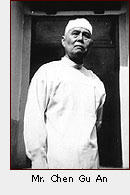
Because of his royal status, Mr. Li Yi-Yu taught his
taijiquan to very few students. One student who helped
spread the art today is Mr. Hao Wei-Zheng (1849-1920).
He was born in Yongnian County and his family was very
poor. He was very honest and a well-respected teacher.
Loved by Mr. Li Yi-Yu, he learned taijiquan from Mr.
Li for many years and never ceased. He mastered the
expert skills of both Mr. Wu Yu-Xiang and Mr. Li Yi-Yu.
Mr. Hao Wei-Zheng has many disciples. His disciples
have proved their taijiquan skills throughout China,
so the taijiquan of Wu family is also called taijiquan
of the Hao family. Mr. Hao respected his master and
grandmaster, so he never considered his boxing the taijiquan
of the Hao family. In the 1960's, his grandson published
a book on taijiquan and called it Wu style taijiquan.
Today, we often call it Wu (Hao) style to give credit
to both Mr. Wu and Mr. Hao.
Mr.
Hao Yueh Ru (son), Mr. Zhang Zhen-zong, Mr. Han Qin-Xian,
Mr. Li Fu-Yiu, Mr. Fan Nian-zu, Mr. Li Shen-Duan (my
grandmaster), Mr. Li Bao-Yu (who taught the Tung family
Mr. Tung Yin-Jie), Mr. Zhong Hao-Tian, and Mr. Sun Lu-Tang
(later he created Sun style taijiquan) were all taught
by Mr. Hao Wei Zheng. From the 1920-1930, Wu (Hao) style
taijiquan was widely spread.
Mr.
Li Shen-Duan (1888-1948), along with Mr. Wang Peng-Nian
and Mr. Hao Zhong-Tian, popularized Wu (Hao) style taijiquan.
Most people who exercise Wu (Hao) style taijiquan in
Xintai were taught by Mr. Li Shen-Duan. Two of the top
students of Mr. Li Shen-Duan are: Mr. Chen Gu-An (1913-1992),
a Chinese Muslim, had the greatest influence in Xintai,
China. He was very famous for his martial arts skills.
When he was younger, he used to be challenged by martial
artists. He was also an expert in Chaquan, Baquazhang,
and Xin-I-quan.
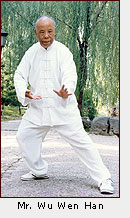 Mr.
Wu Wen-Han (1928-present) retired in Beijing and spent
tremendous amount of time researching the Wu (Hao) taijiquan
theory and application. He has great accomplishments
in the research of the history and theory of taijiquan.
He has published many taiji articles and he is one of
the top taijiquan theorists in China today. He is also
an expert in Yinfu Baquazhang, and Xin-I-quan. Mr.
Wu Wen-Han (1928-present) retired in Beijing and spent
tremendous amount of time researching the Wu (Hao) taijiquan
theory and application. He has great accomplishments
in the research of the history and theory of taijiquan.
He has published many taiji articles and he is one of
the top taijiquan theorists in China today. He is also
an expert in Yinfu Baquazhang, and Xin-I-quan.
Wu
(Hao) Today
From Xian Feng emperor of Qing Dynasty to modern day,
Wu (Hao) taijiquan has developed for 130 to 140 years.
Because there are not many practitioners of this taijiquan
and most of them are scholars and also influenced by
their ancestors and customs, they are reluctant to teach
students. Therefore, the development of Wu (Hao) taijiquan
to some degree is hindered. However, the taijiquan classical
theory created by Mr. Wu Yu-Xiang and Mr. Li Yi-Yu are
abided by all taijiquan teachers and students.
Today,
Wu (Hao) taijiquan is prominent in Xintai, Handan, and
Yongnian of Hebei province, Taiquan of Shanxi province,
Beijing, Tianjing, Shanghai, Shenyang, and Guangzhou.
In America, Wu (Hao) taijiquan is most widely spread
in Texas, Oklahoma, Louisiana, Arkansas, New Mexico,
Colorado, Maryland, and New Jersey. Wu (Hao) may also
be found within Europe in Italy, United Kingdom, Germany,
Sweden, Belgium, Peru, and some South American countries.
Sifu Jimmy Wong is responsible for bringing this art
to these areas. Sifu Jimmy Wong is the 6th generation
direct lineage of the Wu (Hao) taijiquan. He is the
closed-door disciple of both Grandmaster Wu Wen-Han
and Chen Gu-An. In 1998, his student competed against
the Chinese competitors in the 5th 1998 International
Yongnian Taijiquan Championship in Handan, China, and
won 1st place in Wu (Hao) form and Wu (Hao) Taiji sword.
Sifu Wong was also granted the Grandmaster title of
Wu (Hao) style by the China Yongnian Traditional Taijiquan
National Association. He was the only person outside
of China to receive this title. His classmate in China,
Mr. Pang Da-Ming was also granted the Grandmaster title.
His teacher, Mr. Wu Wen-Han was granted the Great Grandmaster
title. Sifu Wong's mission is to spread the Wu (Hao)
taiji and make it available to anyone who is interested.
He recently established the North America Wu (Hao) Taiji
Federation, which is based in Dallas, Texas. He has
a strong belief in preserving the traditional taiji,
and bringing this great style from Yongnian to the rest
of the world. For seminar information or seminar arrangements,
contact (972) 680-7888 or check www.wuhao.org or e-mail
wuhao@chinwoo.com.
|


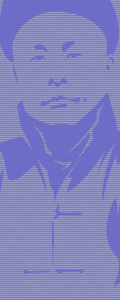
 Wu
style or Hao style, better known as Wu (Hao) style today,
is created by Mr. Wu Yu-Xiang (1812-1880). It is one
of the 5 major Taijiquan systems in China today. The
Wu (Hao) family rose in the year of the Qing Dynasty
when Xiang Feng was the emperor. Mr. Wu Yu-Xiang who
was the founder of the taiji boxing born in Guangfu
town, Yongnian county, Hebei. He was a scholar. His
taiji skills were taught by Chen Qingping, (1795-1868)
who lived in Zhaopao, Wen County, Henan province. With
his Confucianism, Taoism, and Sun Tze Art of War background,
combined with his taiji skill and Mr. Wang Zhong-yue
taiji theory, he developed a powerful taijiquan for
health and martial arts. He also developed the 13 Taiji
Spear (staff), 13 Taiji Saber, and moving step push
hand applications. He carried on the research of Mr.
Wang Zhong-Yue theory and developed the "13-Torso
Method", "Analysis of Taijiquan theory",
"Introduction of the 13 Postures", and "Secret
of the Four Words". Mr. Wu Yu-Xiang had formed
a complete Taijiquan system. Mr. Wu taught his art to
his nephew, Mr. Li Yi-Yu (1832-1892) who also later
developed "The Secret of Five Words", "Taiji
Secret Attacks", and many other concepts. Because
Mr. Wu Yu-Xiang and Mr. Li Yi-Yu were high scholar Confucians,
they amazed themselves by studying the theories and
martial arts aspects of the Taijiquan. They were not
interested in teaching students. Mr. Li accepted Mr.
Hao Wei-Zhang (1849-1920) who later made it very popular
to the public. A famous Xingyi and Baqua teacher, Mr.
Sun-Lu Tang studied from him and created the Sun Style
Taijiquan. A very famous Chinese-Muslim scholar and
a businessman by the name of Mr. Li Shen-Duan in Xintai
studied from Mr. Hao Wei-Zheng. Mr. Li Shen-Duan taught
to many students in the Xintai area. The most famous
ones are Mr. Chen Gu-An, and Mr. Wu Wen-Han. Both taught
and accepted Mr. Jimmy Kokkhang Wong as their disciple.
Wu
style or Hao style, better known as Wu (Hao) style today,
is created by Mr. Wu Yu-Xiang (1812-1880). It is one
of the 5 major Taijiquan systems in China today. The
Wu (Hao) family rose in the year of the Qing Dynasty
when Xiang Feng was the emperor. Mr. Wu Yu-Xiang who
was the founder of the taiji boxing born in Guangfu
town, Yongnian county, Hebei. He was a scholar. His
taiji skills were taught by Chen Qingping, (1795-1868)
who lived in Zhaopao, Wen County, Henan province. With
his Confucianism, Taoism, and Sun Tze Art of War background,
combined with his taiji skill and Mr. Wang Zhong-yue
taiji theory, he developed a powerful taijiquan for
health and martial arts. He also developed the 13 Taiji
Spear (staff), 13 Taiji Saber, and moving step push
hand applications. He carried on the research of Mr.
Wang Zhong-Yue theory and developed the "13-Torso
Method", "Analysis of Taijiquan theory",
"Introduction of the 13 Postures", and "Secret
of the Four Words". Mr. Wu Yu-Xiang had formed
a complete Taijiquan system. Mr. Wu taught his art to
his nephew, Mr. Li Yi-Yu (1832-1892) who also later
developed "The Secret of Five Words", "Taiji
Secret Attacks", and many other concepts. Because
Mr. Wu Yu-Xiang and Mr. Li Yi-Yu were high scholar Confucians,
they amazed themselves by studying the theories and
martial arts aspects of the Taijiquan. They were not
interested in teaching students. Mr. Li accepted Mr.
Hao Wei-Zhang (1849-1920) who later made it very popular
to the public. A famous Xingyi and Baqua teacher, Mr.
Sun-Lu Tang studied from him and created the Sun Style
Taijiquan. A very famous Chinese-Muslim scholar and
a businessman by the name of Mr. Li Shen-Duan in Xintai
studied from Mr. Hao Wei-Zheng. Mr. Li Shen-Duan taught
to many students in the Xintai area. The most famous
ones are Mr. Chen Gu-An, and Mr. Wu Wen-Han. Both taught
and accepted Mr. Jimmy Kokkhang Wong as their disciple.


 Mr.
Wu Wen-Han (1928-present) retired in Beijing and spent
tremendous amount of time researching the Wu (Hao) taijiquan
theory and application. He has great accomplishments
in the research of the history and theory of taijiquan.
He has published many taiji articles and he is one of
the top taijiquan theorists in China today. He is also
an expert in Yinfu Baquazhang, and Xin-I-quan.
Mr.
Wu Wen-Han (1928-present) retired in Beijing and spent
tremendous amount of time researching the Wu (Hao) taijiquan
theory and application. He has great accomplishments
in the research of the history and theory of taijiquan.
He has published many taiji articles and he is one of
the top taijiquan theorists in China today. He is also
an expert in Yinfu Baquazhang, and Xin-I-quan.